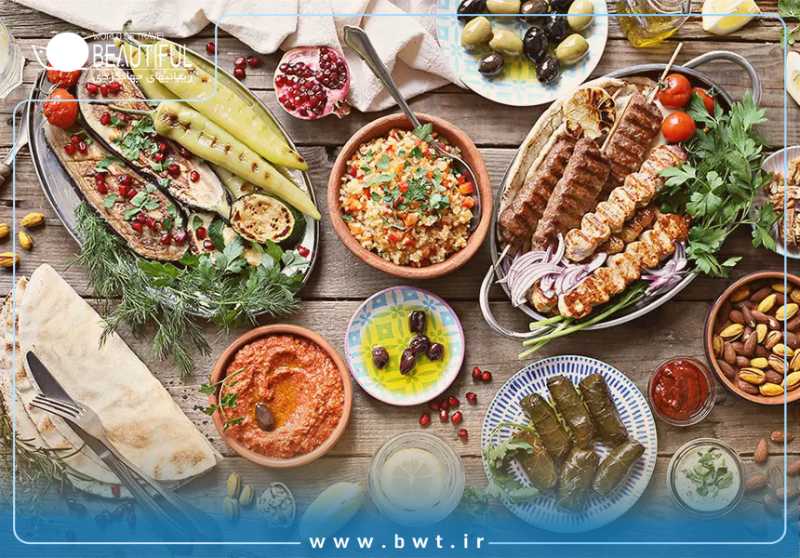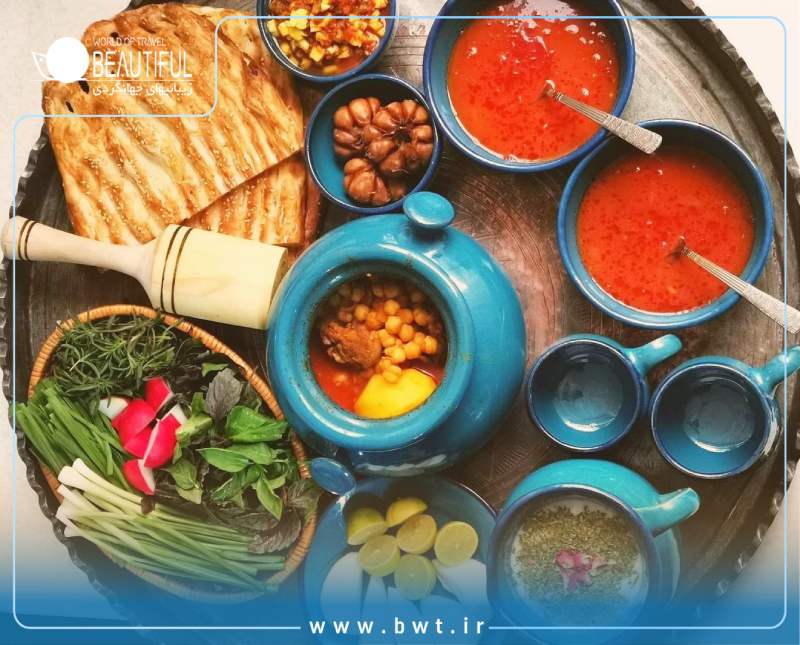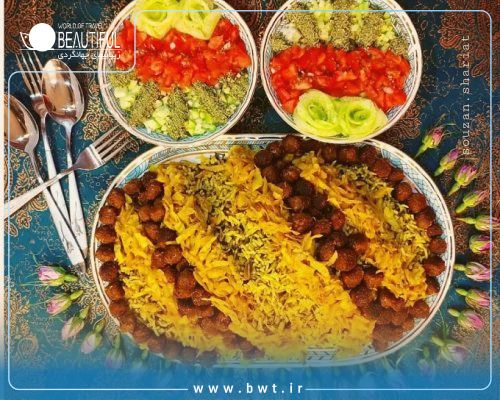Iran, a country with a rich history and diverse culture, is not only known for its historical and natural attractions but also for its delicious and varied cuisine. Iranian dishes are a unique blend of flavors, colors, and aromas that delight every palate. The country’s food culture combines the best of different regions, incorporating fresh ingredients and traditional cooking methods that make each dish stand out. Iranian cuisine is a source of national pride, and its flavors are increasingly being recognized globally.
This article from the World of Travel Beautiful explores the reasons behind the worldwide fame of Iranian foods and introduces some of the most popular dishes.
Why Are Iranian Foods So Popular?
Unmatched Diversity: Iran boasts a wide range of climates and regions, each offering its own distinct dishes. From the seafood-based meals of the northern coast to the grilled kebabs of the south and the stews of the central plains, Iranian cuisine is as diverse as its geography. Each region has its own unique ingredients and cooking techniques, contributing to the broad spectrum of flavors and textures found in Iranian food. This regional diversity ensures that there is something for everyone, whether one enjoys savory, sweet, or spicy dishes.
Fresh and Natural Ingredients: One of the key factors behind the deliciousness of Iranian food is the use of fresh, high-quality ingredients. Vegetables, herbs, meats, and nuts are commonly used, and the food is often prepared with an emphasis on freshness. Iranian chefs take pride in sourcing the best produce available and incorporating seasonal ingredients, which enhances the taste and nutritional value of their dishes. This focus on natural, locally-sourced ingredients sets Iranian cuisine apart from many others and ensures its lasting appeal.

Focus on Taste and Aroma: Iranian cuisine places a great deal of emphasis on achieving perfect flavor combinations. The use of fragrant spices such as saffron, cinnamon, ginger, and cardamom adds complexity and depth to Iranian dishes. Each spice is carefully chosen to balance the flavors of the dish, and the resulting aroma and taste are what make these meals so distinctive. The skillful use of spices, paired with fresh herbs, elevates the dining experience and leaves a lasting impression on those who try it.
Traditional Cooking Methods: Many Iranian dishes are prepared using traditional cooking techniques that have been passed down through generations. For example, the slow-cooking method used in stews helps to blend the flavors and tenderize the ingredients, creating dishes that are rich and savory. In addition, the use of clay or copper pots for cooking enhances the taste, as these materials retain heat evenly and help to preserve the aroma and moisture of the food. These time-honored techniques give Iranian food its distinct character and appeal.
Health and Nutrition: Iranian cuisine is often considered to be healthy and nutritious. It incorporates a variety of legumes, vegetables, and whole grains, which are rich in fiber, vitamins, and minerals. Additionally, many Iranian dishes are cooked using healthy oils, such as olive oil, and feature lean meats like chicken and lamb. The balanced nature of Iranian meals, which include a mix of protein, carbohydrates, and healthy fats, makes them not only delicious but also nourishing.
Popular Iranian Dishes Around the World
Kebabs: Iranian kebabs, including koobideh (minced meat kebab), barg (grilled lamb or beef), joojeh (grilled chicken), and chenjeh (skewered meat), are some of the most famous and widely loved dishes globally. These kebabs are marinated in a blend of spices and grilled to perfection, offering a smoky, flavorful experience. Served with rice or flatbread and accompanied by grilled vegetables, kebabs are a favorite in both Iran and many countries around the world.

Stews: Iranian stews, or khoresh, are rich, flavorful dishes that have become iconic parts of Iranian cuisine. Some of the most popular stews include ghormeh sabzi (a herb-based stew with lamb), fesenjan (a pomegranate and walnut stew), and khoresh gheymeh (a stew made with split peas and lamb). These stews are often served with saffron rice and are known for their complex flavors, blending sour, sweet, and savory elements.
Pilafs: Rice is a staple in Iranian cuisine, and dishes like zereshk polo (rice with barberries and chicken), baghali polo (rice with dill and fava beans), and adassi polo (lentil pilaf) are popular both in Iran and abroad. These rice dishes are often cooked with aromatic spices, herbs, and garnished with nuts and dried fruits, making them flavorful accompaniments to meat dishes.
Soups: Iranian soups, such as ash reshteh (a thick noodle soup with beans, greens, and herbs) and ash-e doogh (a yogurt-based soup), are traditional and nutritious dishes that are loved for their comforting qualities. These soups often incorporate a variety of legumes, herbs, and vegetables, making them filling and wholesome.
Desserts: Iranian desserts are known for their sweet, delicate flavors, with dishes such as baklava (sweet pastry with nuts and honey), zolbia and bamieh (fried dough soaked in syrup), and sholeh zard (saffron rice pudding) being among the most beloved. These desserts are often flavored with rosewater, saffron, and cardamom, which give them a distinct fragrance and taste.
How to Try Iranian Food?
Iranian Restaurants: Iranian restaurants are present in many cities around the world, offering a fantastic opportunity to experience authentic Iranian cuisine. These restaurants typically serve a wide variety of dishes, from kebabs to stews to rice dishes, giving diners a taste of Iran’s rich food culture.
Iranian Cooking Classes: For those who want to learn how to cook Iranian dishes themselves, many cities offer Iranian cooking classes. These classes provide an excellent chance to get hands-on experience in preparing classic Iranian meals, and participants can take home new skills to recreate these dishes in their own kitchens.

Travel to Iran: The best way to experience authentic Iranian food is by traveling to Iran itself. In addition to visiting famous restaurants, travelers can enjoy home-cooked meals prepared by local families, gaining insight into the food culture of different regions. This immersive experience offers a deeper understanding of the flavors and techniques that make Iranian cuisine so special.
Conclusion
Iranian cuisine is famous for its variety, unique flavors, and rich cultural heritage. The combination of fresh, high-quality ingredients, traditional cooking methods, and a focus on taste and health make Iranian food a beloved culinary tradition. Whether you are enjoying a dish in an Iranian restaurant abroad or cooking it at home, Iranian food offers an unforgettable experience that reflects the history and culture of this fascinating country. For anyone looking to expand their culinary horizons, Iranian cuisine is a must-try.
If you're planning to travel to Iran and want to gather more information about the country's attractions, culture, and travel tips, visit the "World of Travel Beautiful" website. It offers comprehensive guides and resources to help you plan your trip to Iran.
(FAQs)
1. What are some popular Iranian dishes?
-
Kebab: Iran is famous for its delicious kebabs such as koobideh (minced meat kebab), joojeh (grilled chicken), and barg (grilled lamb).
-
Stews: Iranian stews like ghormeh sabzi (herb stew with lamb), fesenjan (pomegranate and walnut stew), and khoresh gheymeh (split peas and lamb stew) are loved for their rich flavors.
-
Rice dishes: Pilafs like zereshk polo (barberry rice with chicken) and baghali polo (rice with dill and fava beans) are staples in Iranian meals.
-
Desserts: Popular Iranian desserts include baklava, zolbia, bamieh (fried dough soaked in syrup), and sholeh zard (saffron rice pudding).
2. What makes Iranian food so unique?
3. Is Iranian food healthy?
4. How can I try Iranian food outside of Iran?
-
Iranian restaurants: Many cities around the world have Iranian restaurants where you can taste authentic dishes. These restaurants typically offer a variety of kebabs, stews, rice dishes, and desserts.
-
Cooking classes: You can also take Iranian cooking classes to learn how to prepare these dishes yourself. Many cooking schools or local chefs offer classes where you can master the art of Iranian cuisine.
-
Food festivals: Some international food festivals feature Iranian food, giving you a chance to sample different dishes in one place.














